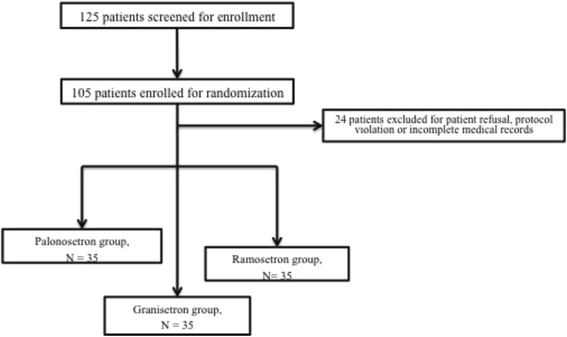Comparison of palonosetron, granisetron, and ramosetron for the prevention of postoperative nausea and vomiting after laparoscopic gynecologic surgery: a prospective randomized trial
- PMID: 26335706
- PMCID: PMC4558835
- DOI: 10.1186/s12871-015-0102-0
Comparison of palonosetron, granisetron, and ramosetron for the prevention of postoperative nausea and vomiting after laparoscopic gynecologic surgery: a prospective randomized trial
Abstract
Background: Selective 5-hydroxytryptamine type 3 (5-HT3) receptor antagonists are reported to have potent antiemetic effects for postoperative nausea and vomiting (PONV). The purpose of this study was to prospectively evaluate the efficacy of palonosetron, granisetron, and ramosetron for the prevention of PONV in patients undergoing laparoscopic gynecologic surgery.
Methods: In this prospective, randomized observational study, 105 healthy female patients who were undergoing laparocopic hystectomy under general anaesthesia were enrolled (clinical trial number: NCT01752374, www.clinicaltrials.gov ). Patients were divided into three groups: the palonostron (0.075 mg i.v.; n = 35), the granisetron group (3 mg i.v.; n = 35), and the ramosetron group (0.3 mg i.v.; n = 35). The treatments were given before the end of surgery. The incidence of PONV, severity of nausea/vomiting, and the use of rescue antiemetic requirements during the first 48 h after surgery were evaluated.
Results: The overall incidence of PONV was 33.3 % for this series. The number of complete responders at 48 h after the surgery was 21 (60.0 %) for palonosetron, 24 (68.6 %) for granisetron, and 26 (71.4 %) for ramosetron, representing no statistical difference (P = 0.086).
Conclusions: There were no significant differences in the overall incidence of postoperative nausea and vomiting and complete responders for palonosetron, granisetron and ramosetron group.
Clinical trial number: NCT01752374 , www.clinicaltrials.gov .
References
-
- Eriksson H, Korttila K. Recovery profile after desflurane with or without ondansetron compared with propofol in patients undergoing outpatient gynecological laparoscopy. Anesth Analg. 1996;82:5336. - PubMed
-
- Sohi HS, Heipel J, Inman KJ, Chinnick B, Cunningham DG, Holliday RL, et al. Preoperative transdermal scopolamine does not reduce the level of nausea and frequency of vomiting after laparoscopic cholecystectomy. Can J Surg. 1994;37:3074. - PubMed
Publication types
MeSH terms
Substances
Associated data
LinkOut - more resources
Full Text Sources
Other Literature Sources
Medical


